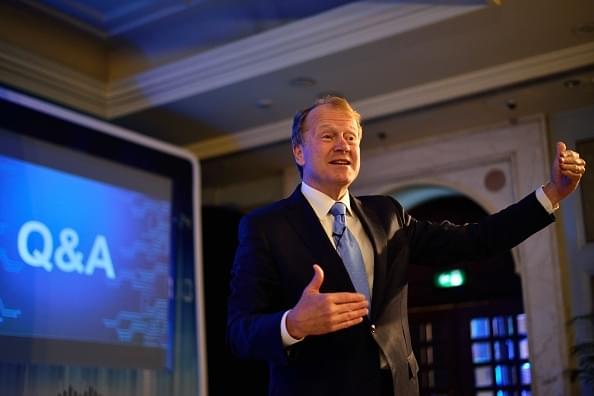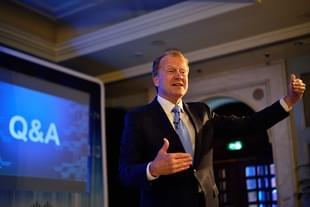Economy
Cisco’s John Chambers: I’d Give India An ‘A’ For Progress In The Last Three years
Amrit Raj
Aug 03, 2017, 11:48 AM | Updated 11:47 AM IST
Save & read from anywhere!
Bookmark stories for easy access on any device or the Swarajya app.


John Chambers, 67, executive chairman of Cisco Systems Inc, has been a long-time supporter of India and an admirer of Prime Minister Narendra Modi who, he says, gets it when it comes to creating a digital country. Chambers was in India to announce the creation of the US-India Strategic Partnership Forum (USISPF) which he says will take the relationship between the two countries, their companies, and their people, to the next level. The body was created after the existing team of the US India Business Council decided to leave, and the body’s parent, the US Chambers of Commerce decided to merge USIBC with itself. In an interview, Chambers spoke about the new body, India, Prime Minister Modi. Edited excerpts:
Tell us about this new body you are creating. How is it going to be different from existing bodies?
It is different in every way. It is focused on future and it is completely independent. It has 100 per cent focus on the next major technology business societal shift. So, it is really thinking about where we want to be 10-20 years from today and we thought about it and we realised this can’t be an evolution. Every major company knows that they are at an inflection. That is why I like your prime minster so much because he does so much of it so well. He sets a goal. He outlines a vision that gives people hope. That’s why we were so excited about what we can do with this kind of an organization structure.
It is company to government; company to their customers; customers could be consumers or business. It could be companies to start-ups; start-ups together with common goals.
We see the potential of what next generation strategic partnerships can be. Not on trade but more importantly on the society, economic growth, job creation, inclusion, innovation and a new generation of entrepreneurship; if we do this right between our two nations, I think it will not only have major economic impact on the citizens of both nations in a very positive way but it will be a model for others.
At a transactional level, this will also guide US companies that want to do business in India and Indian companies that want to do business in the US?
It very much could. They tend to trust us. The governments seem to trust us. We have complete support from all the political leaders (in both countries) almost regardless of political parties.
You have been a regular visitor to India, and have been working closely with the government for the past few years. What changes do you see?
Let me frame the whole context. Obviously, I am a huge believer in India and I love the country. I think India has some most advanced digital vision and strategy in the world. I see the Prime Minister as one of the top leaders that I have ever met in my life. He has got a vision and a strategy; he knows how to execute them for India’s 1.3 billion people. I think it has been a remarkable progress.
When Prime Minister Modi was elected, I very quickly listened to him and decided to bet on India in a big way as I believed in his vision and strategy. He knows how to form win-win partnerships that most people don’t. He is willing to take the risk that goes with it. Some people might be critical saying he hasn’t moved fast enough. He is moving faster than any leader in the world. (For instance), without the Goods and Services Tax, companies firms are not going to invest here; without it, you are never going to be a manufacturing powerhouse.
You would have said there is no way he would (be able to) do that, yet he has. I would give India an A in terms of progress over the last three years vs. an A+ for what people have thought of doing. But... there is always room for improvement.
Any negatives?
It surprised me, but India tends to be critical of itself and I think that faster people buy the vision and understand what’s possible (the better). That’s how you move to a speed that is equal with others.
Do you think it is easier to do business in India now than it was before?
Absolutely! I could not manufacture in India three years ago; (it was) not an option. I can now manufacture in India very effectively. We have opened our plants. Now, we have to see how do we get the efficiencies where we can use India as an export engine.
What are Cisco’s plans in India?
India is our second headquarters. Every time we bet on India... 1997, we bet in a big way on India. We made it our second headquarters; later we made it our Digitisation headquarters. Forty per cent of our engineering head count is of Indian ancestry.
Using H1-B visas to replace US workers with Indians a mistake: Cisco chairman
So, we are very optimistic about India. India was our top country last year from the sales side. It is our great source in terms of talent and not labour arbitrage.
Finally, a question on culture. Cisco is a quintessential new economy company based on the West Coast. A lot of new economy start-ups are in trouble over how they are run, the kind of culture they have. You never had these kind of issues. So what did you do right and what are these people doing wrong?
A couple of things. Every company will make mistakes and every company has bumps. But if you look at the role of the CEO, he/she only has four jobs: vision and strategy for the company, (recruit and periodically change the) management team to implement that vision and, (to create a) culture, and communicate all the above. And culture to me... People say that culture eats vision; I don’t buy that. I mean it’s one of the four elements but our culture — we put it on the badge... culture is a huge part of who you are. The culture is what broke down Uber ... is often what either gets a company to be very successful or cause it to lag behind. I am very proud of (Cisco’s) culture. Mint





